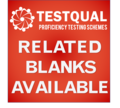Proficiency Tests
Accreditation and Standards
Standards used to design this proficiency test :
- Proficiency test Not accredited, but based in UNE-EN ISO/IEC 17043:2023 General requirements for proficiency testing. Check our accreditation scope.
- UNE-EN ISO/IEC 15328:2015 Statistical methods for use in proficiency testing
- HARMONIZED PROTOCOL FOR THE PROFICIENCY TESTING OF (CHEMICAL) ANALYTICAL LABORATORIES
- SANTE Guide into force: ANALYTICAL QUALITY CONTROL AND METHOD VALIDATION PROCEDURES FOR PESTICIDE RESIDUES ANALYSIS IN FOOD AND FEED
- Quick Polar Pesticides Method (QuPPe) latest version.
Why TestQual proficiency test ?
| Now you can receive your evaluation within days after the deadline to submit results. New reporting implemented! |
- 20 years of experience in proficiency test s since TestQual's foundation.
- Customized reports: Global report, individual reports, and option for reports by analyte groups.
- Fortification and quality controls available for participants upon request.
- Distributor network: Conveniently place orders in your local language and without worrying about time differences. participation confidentiality is not compromised.
- We take care of everything so you can focus on the analysis.
- Customer service and quick support on all our channels (email, phone, web).
- Innovation and cost-effectiveness: Constant negotiation of shipping costs and materials to ensure your samples arrive in perfect condition and for the best price.
| Our proficiecny test provide you a great way to demonstrate the quality of your analysis and it will contribute to the continuous improvement. We aim to meet your needs and exceed your expectations. |
Proficiency test Information
This proficiency test will consist of a single round, in which a sample will be distributed on the specified date (see calendar). Detailed information about this Proficiency test can be found in the protocol (Calendar, sample quantity, analytes, concentrations, deviation/deviations from target standard). The protocol can be downloaded from the right column of this page.
Intercomparison Calendar
Check the right column of this page, in the "Dates" section.
*These dates are indicative and should always be verified with the dates in the Proficiency test protocol and with the news on the TestQual homepage.
Only registered participants in this proficiency test will receive emails with instructions and confirmation of the definitive distribution date.
Analytes
| Chlorate |
| Perchlorate |
| Quaternary Ammonium Compounds |
| Plaguicidas Multiresiduos |
Why participate in a proficiency test program?
Participating in TestQual's proficiency test programs can help you maintain the utmost confidence in your results. The ability of laboratories to analyze and obtain reliable results is crucial for public health. TestQual's proficiency tests provide an opportunity to compare your analysis results with participants from all around the world, allowing you to evaluate your results over time and detect any deviations for prompt correction (specially now that we offer fast evaluation). While a single participation may reveal potential errors, the true value of TestQual's proficiency tests lies in regular and continuous participation, along with each laboratory's internal quality controls, ensuring proper control of the proposed parameters' analysis.
Multiresidue pesticides - QuEChERS
Pesticide control is a very important routine analysis to ensure that foods comply with legislation and are safe for consumption. Laboratories must be able to correctly detect and quantify, among hundreds of possible pesticides, whether an analyte is present in the sample and at what concentration, always avoiding reporting false positives. Maximum Residue Limits (MRLs) for pesticides indicate the maximum amount a matrix should contain so that the presence of these pesticides cannot be a problem for consumer health, to facilitate the marketing of products, and to control the use of plant protection products. The decision regarding MRLs is based on many variables, including toxicological data, metabolism, and persistence in various media. MRLs can be consulted in the annexes of Regulation 396/2005 and an updated list of pesticides and their MRL per matrix can be found. You can check the list of possible pesticides present in the sample in the Proficiency test protocol, which can be downloaded in the right column of this page.
Chlorate
The past 2020 chlorate underwent a modification of the allowed Maximum Residue Limits (MRLs), this update is due to the fact that in multiple matrixes, the default MRL has been exceeded. (c1) This compound, in addition to its previous use as a pesticide, is also a byproduct of chlorine disinfectants and appears when treating drinking water (c1), (c2). For certain subgroups of the European population, such as iodine-deficient children and lactants, it was found that the tolerable daily intake was exceeded. Therefore, in addition to establishing a plan to reduce the presence of this contaminant as much as possible (As Low As Reasonably Achievable - ALARA principle), the MRLs for this compound were also updated (c1). Until 2025, when these MRLs are planned to be reviewed, they can be consulted in COMMISSION REGULATION (EU) 2020/749 of June 4, 2020 (c3).
Perchlorate
Perchlorate is a persistent contaminant (p1) and, although it is not carcinogenic, it is goitrogenic. It can be found in fruits and vegetables and may result from the use of fertilizers containing nitrate, contaminated irrigation water, and water disinfected with chlorinated substances (p2). For perchlorate, on 2020, a new regulation REGULATION (EU) 2020/685 OF THE COMMISSION of May 20, 2020, came into effect, by which the MRLs for this contaminant were updated (p3). The chronic effect due to continuous exposure to chlorate and perchlorate causes the inhibition of iodine uptake in humans, due to the formation of Methemoglobin, which is a hemoglobin incapable of releasing oxygen. This inhibition can cause hypertrophy and improper functioning of the hormonal system of the thyroid gland (hypothyroidism), causing alterations in the hormonal system of the thyroid affecting the correct development and growth of infants and children. Depending on the level of exposure, it has also been detected to cause the development of multinodular goiter (enlargement of the thyroid gland), leading to hyperthyroidism (p4).
Quaternary Ammonium Compounds (QAC)
For quaternary ammonium compounds, DidecylDimethylAmmonium Chloride (DDAC) with alkyl chains of a length of C-X and AlkylBenzyldimethyAmmonium Chlorides (BAC) chlorides with alkyl chains of a length of C-X, the current MRLs that must be met for these compounds were established and are still in force by COMMISSION REGULATION (EU) No 1119/2014 of October 16, 2014. DDAC was used as a plant protection product for some time, but after its repeal in 2009 (q1), its use for plant protection in the EU is no longer authorized (q2). Nowadays, the cause of finding residues of these compounds in our food is their use as a biocide for disinfection, especially after the presence of the coronavirus pandemic, where all producers ensures that their products are free of viral load.
How to register for participation
Laboratories that wish to participate and are not yet registered on our website can do it completing the
REGISTRATION FORM.
If your laboratory is already registered on our website, you can request the participation in this proficiency test by clicking the "Participate" button located both at the top right and bottom of this page. After loggin in, in the PARTICIPATION REQUEST, you must submit your quantification limits of the analytes your laboratory studies. This information is reviewed to ensure the participation will be useful to your laboratory.
Analytes marked as "Not analyzed" (NA) will not appear later, when submitting your data in the results' form. We want to help you focus on the analysis and save you time while giving the best service: you can contact our team and they will give you different options to allow the inscription to this proficiency test, saving time and still ensuring the participation will be useful.
Once the registration is submitted, you will receive an email with your laboratory code for participation in this Proficiency test as soon as possible. Limits of Quantification are requested to ensure that the proficiency test will be useful for you, and in case of any doubts, we would contact you, so you can make an informed decision about your participation. Our aim is to help you showcase your quality.
| Receiving the TestQual laboratory code is synonymous with useful participation in proficiency testing. |
Contact
If you would like a quote or if we can assist you in any way, you can contact us through:
| testqual@testqual.com | |
| Office Phone | (+34) 868-94-94-86 |
| Mobile Phone | (+34) 676-367-555 |
Thank you very much for your interest/trust in TestQual and our proficiency test programs.






